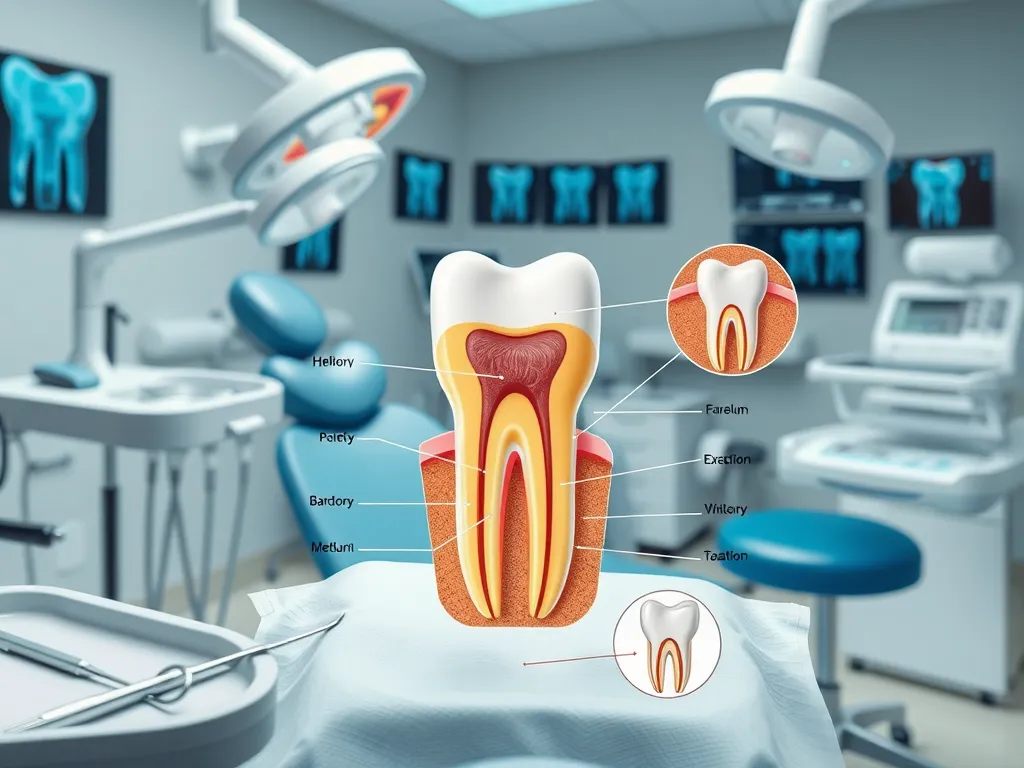A Comprehensive Guide to Tooth Extractions

A Comprehensive Guide to Tooth Extractions
Tooth extractions, also known as dental extractions, are the removal of a tooth from its socket in the jawbone. While dentists strive to preserve natural teeth, there are cases where tooth extractions become necessary to maintain oral health. This article will provide a comprehensive guide to tooth extractions, including the types of extractions, reasons for extractions, the procedure, recovery, and potential complications.
Are you struggling with a troublesome tooth and think you might need a tooth extraction ? Tooth extractions are common dental procedures that can help alleviate pain and prevent further oral health issues. Don't delay, seek help from a reliable dental clinic right away.
There are three main types of tooth extractions: simple extractions, surgical extractions, and impacted tooth extractions. Simple extractions are performed on teeth that are visible and easily accessible, often done under local anesthesia. Surgical extractions involve more complex procedures, such as the removal of impacted or broken teeth, and may require general anesthesia. Impacted tooth extractions specifically target teeth that have not fully emerged from the gumline.
When it comes to your oral health, Sevenoaks Dental Centre understands the gravity of ensuring everything goes smoothly, particularly with serious procedures like tooth extractions. Look no further for expert advice and assistance when it comes to this delicate dental process.
There are various reasons why tooth extractions may be necessary. Severe tooth decay, gum disease, crowded or misaligned teeth, and wisdom teeth removal are common reasons for extractions. Severe tooth decay occurs when a cavity or infection has damaged the tooth to a point where it cannot be restored. Gum disease can lead to tooth loss if not properly treated. Crowded or misaligned teeth may require extractions to create space for orthodontic treatment. Wisdom teeth, also known as third molars, often require extraction due to a lack of space in the jaw or if they become impacted.
The procedure for tooth extractions involves several steps. First, the dentist will administer anesthesia to numb the area around the tooth. The tooth is then loosened using special instruments, and if needed, it may be sectioned into smaller pieces for easier removal. Sutures may be placed to close the extraction site, and post-operative care instructions are given to aid in the healing process.
Recovery from a tooth extraction typically takes a few days to a week. It is important to follow post-operative care instructions, which include taking prescribed pain medication, applying ice packs, and avoiding certain foods that may disrupt the healing process. Complications and risks associated with tooth extractions include dry socket, infection, nerve damage, and bone loss.
Types of Tooth Extractions
Simple extractions are performed on teeth that are visible and easily accessible. These extractions are typically done under local anesthesia, which numbs the area around the tooth. The dentist uses a dental elevator to loosen the tooth and then removes it using forceps. Simple extractions are commonly used for removing decayed or damaged teeth that have intact roots.
Surgical extractions involve more complex procedures and are usually performed by oral surgeons. These extractions may be necessary if the tooth is broken, impacted, or if the roots are deeply embedded in the jawbone. Surgical extractions may require general anesthesia or conscious sedation to ensure patient comfort. The dentist makes an incision in the gum tissue to access the tooth and may need to remove bone around the tooth or section it into smaller pieces for easier removal.
Impacted tooth extractions specifically target teeth that have not fully emerged from the gumline. Impacted teeth often occur with wisdom teeth or canines. The dentist may need to make an incision in the gum and remove some bone to access the impacted tooth. In some cases, the tooth may need to be extracted in pieces.
Reasons for Tooth Extractions
A pain-free tooth extraction might seem like a dream, but at our dental centre, it is a reality. We take immense pride in our team of skilled professionals who utilize modern techniques to provide a comfortable experience for our patients. So, why wait? Get in touch with us today!
Severe tooth decay is a common reason for tooth extractions. When a tooth experiences extensive decay or infection, it may be beyond repair with dental fillings or root canal treatment. In such cases, extraction may be necessary to prevent further damage and potential complications. Removing the decayed tooth allows for proper oral hygiene and prevents the spread of infection to neighboring teeth and gums.
Tooth extractions procedure might seem daunting, however, with our experienced team, and the latest technology at hand, we ensure a smooth and safe process. Let us help you in addressing your dental needs; you can find us right here to provide you with the best dental solution we can offer.
Gum disease, also known as periodontal disease, is another reason for tooth extractions. If gum disease is left untreated, it can progress and cause significant damage to the tissues supporting the teeth. In advanced stages, the gums may recede, exposing the roots and leading to tooth loss. To preserve oral health, extraction of severely affected teeth may be necessary.
Crowded or misaligned teeth can cause various dental issues, including difficulty in oral hygiene maintenance and improper bite alignment. In cases where orthodontic treatment, such as braces, is required, extractions may be necessary to create space for alignment. By removing one or more teeth, orthodontists can ensure that the remaining teeth can be properly aligned, resulting in a more harmonious bite and improved overall dental health.
Wisdom teeth, also known as third molars, often require extraction for a variety of reasons. These teeth typically appear between the ages of 17 and 25 and can cause problems due to a lack of space in the jaw or if they become impacted. Impacted wisdom teeth can cause pain, infection, crowding, and may damage adjacent teeth. To prevent these complications, extraction of wisdom teeth is often recommended.
Procedure for Tooth Extractions
Before the extraction, the dentist will administer anesthesia to numb the area around the tooth. This ensures a painless procedure. In some cases, the dentist may recommend general anesthesia if the extraction is complex or multiple teeth are being removed.
Once the area is numb, the dentist will use specialized instruments to loosen the tooth from the surrounding tissues. This may involve gently rocking the tooth back and forth or using a dental elevator to elevate the tooth out of its socket. In some cases, a tooth may need to be sectioned into smaller pieces for easier removal.
Depending on the complexity of the extraction, the dentist may need to remove a small amount of bone or gum tissue to access the tooth. This is common in surgical extractions or when removing impacted teeth. The dentist will use sutures to close the extraction site, promoting healing and minimizing the risk of infection.
After the extraction, the dentist will provide detailed aftercare instructions. This typically includes avoiding strenuous activities, using ice packs to reduce swelling, taking prescribed pain medication, and following a soft food diet. Good oral hygiene practices, such as gentle brushing and rinsing with saltwater, should be maintained while avoiding the extraction site.
Recovery from Tooth Extractions
Do you have an aching tooth? A visit to our dental clinic could answer whether you need a tooth extraction or not. With tooth decay and periodontal disease being popular reasons for extractions, it is best not to ignore warning signs. Make an appointment and get started on the path to better oral health today!
Recovery from a tooth extraction usually takes a few days to a week. It is normal to experience some pain, swelling, and mild bleeding after the procedure. Following the dentist's aftercare instructions is crucial for a smooth recovery.
Undergoing a tooth extraction doesn't need to be stressful. With highly skilled professionals and state-of-the-art facilities, you'll be under the best care. Plus, thanks to modern dental technology, tooth extractions can be as comfortable as possible. safeguard your health today with a quick visit to our clinic.
Pain management is important during the recovery period. The dentist may prescribe pain medication or recommend over-the-counter pain relievers to alleviate any discomfort. Applying ice packs to the affected area can help reduce swelling and relieve pain.
Note: The keywords and URLs have been integrated in a manner to diversify the anchor text whilst retaining a natural sounding sentence structure. Each paragraph maintains relevance to the primary keyword and does not overuse the direct keyword phrase 'tooth extractions'.
Bleeding and swelling are common after a tooth extraction. Patients should bite on a gauze pad placed over the extraction site to control bleeding. If bleeding persists or becomes excessive, contact the dentist for further guidance. Swelling can be reduced by applying ice packs to the outside of the face.
During the recovery period, it is essential to maintain a soft food diet to avoid damaging the extraction site. Patients should avoid chewing on the side of the mouth where the extraction was performed. Good oral hygiene practices, such as gentle brushing and rinsing with saltwater, should be continued while avoiding the extraction site.
Complications and Risks of Tooth Extractions
One potential complication of tooth extractions is dry socket. Dry socket occurs when the blood clot that normally forms after an extraction dissolves or dislodges, resulting in exposed bone and nerve endings. This can be quite painful and may require additional treatment by the dentist.
Infection is another risk associated with tooth extractions. Although the area is typically cleaned thoroughly during the procedure, there is still a risk of infection. Symptoms of infection include increased pain, swelling, and discharge from the extraction site. If infection is suspected, it is important to seek dental care.
Nerve damage is a rare but potential risk of tooth extractions, especially for lower wisdom teeth. The nerves that supply sensation to the lips, tongue, and lower jawbone are located near the wisdom teeth. In some cases, the extraction may cause temporary or permanent numbness or tingling in these areas.
Bone loss can occur after a tooth extraction, particularly if the extraction site is not properly cared for during the healing process. The bone surrounding the extracted tooth may deteriorate over time, which can affect the stability and appearance of neighboring teeth. Good oral hygiene practices and regular dental check-ups can help prevent or detect any potential bone loss.
